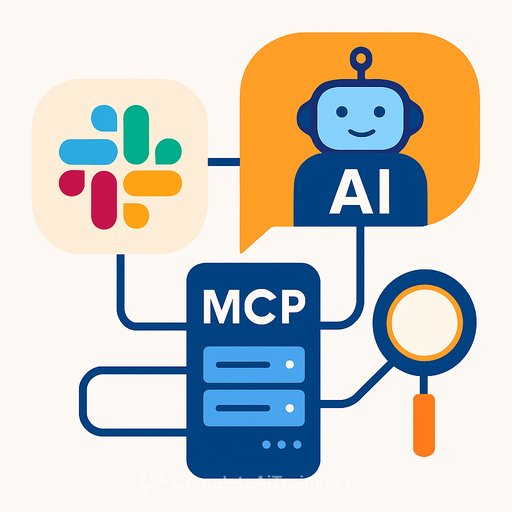Slack adds MCP server and real-time search: practical AI agents for your workspace
Slack is rolling out new developer tools that make AI agents both useful for employees and manageable for IT. A real-time search API and a model context protocol (MCP) server let agents work with Slack conversations and files securely, with less custom plumbing.
The goal: accurate answers in the flow of work, fewer app switches, and a cleaner path to deployment at scale.
What's new
- Real-Time Search (RTS) API: Grants agents on-demand access to Slack messages and files without bulk exports. Results respect existing user and channel permissions and only return content relevant to a query.
- MCP server for Slack: Based on Anthropic's open-source Model Context Protocol. It standardizes how agents discover tools, fetch context, and execute actions, reducing one-off integrations and per-LLM wiring.
- Third-party agents in Slack: Integrations with assistants like Claude and Perplexity let users ask questions grounded in live Slack context from within their workspace.
- Work Objects: A unified way to display third-party data in Slack with rich previews and inline actions (e.g., complete an Asana task) without switching screens.
- Agentic developer tools: AI best practices, prebuilt Block Kit Tables, and updated resources including the CLI for Bolt to speed up build, test, and rollout.
Why IT should care
These updates keep data where it lives and align with permission boundaries you already maintain. That means less risk from shadow exports and fewer bespoke app permissions to manage.
As Slack's chief product officer Rob Seaman put it, agents can prep talking points, analyze docs, manage incidents, and track projects "right next to where you talk to your colleagues," while IT gets a cleaner deployment path with the right permissions in place.
How it works in practice
- RTS API: Tools like Notion or Dropbox Dash can surface the latest Slack conversations across public/private channels and DMs based on the user's access, enabling real-time context without data duplication.
- MCP server: Vendors like Anthropic and Perplexity use MCP to ground responses in Slack. Perplexity notes this expands use cases and boosts confidence in results by anchoring to current conversations.
Frank te Pas, head of enterprise product at Perplexity, said the MCP connection helps deliver answers that feel accurate and relevant because they're backed by the threads your teams already trust.
Availability and pricing
- RTS API + MCP server: Closed beta now; general availability expected in early 2026.
- Third-party agents: Available today in the Slack Marketplace. Pricing is set by each vendor.
- Work Objects: GA for all developers in late October.
Quick start for IT and platform teams
- Pick 1-2 high-value use cases (incident response runbooks, sales Q&A from deal rooms, policy lookup) and pilot in a dedicated channel.
- Apply for the RTS/MCP beta and define scopes that mirror your least-privilege standards; enable only the channels required for the pilot.
- Enforce guardrails: message visibility by user context, audit logs, PII redaction, and data retention aligned with existing Slack policies.
- Set evaluation criteria: accuracy, citation coverage, response latency, failure modes, and fallback behavior.
- Plan rollouts via Slack app policies, SSO, SCIM groups, and change windows; document a clear ownership model for agent behavior.
Build notes for developers
- Use MCP to expose tools (e.g., "summarize thread," "create Jira issue," "fetch doc") once, not per-LLM. Keep tools idempotent and auditable.
- Lean on RTS for on-demand retrieval. Avoid shadow stores; cache minimally with TTLs and include message links for traceability.
- Return citations and channel/message IDs in responses so users can verify sources and click through.
- Adopt Work Objects for consistent previews and inline actions; pair with Block Kit Tables for scannable results.
- Instrument everything: request IDs, token usage, latency buckets, error types, and redaction events. Route logs to your SIEM.
- Define safe fallbacks (e.g., "I don't have access to that channel" or "No matching messages found") rather than hallucinating answers.
Resources
Upskill your team
If you're rolling out agents or integrating MCP/RTS, level up your team's AI skills with role-based training.
Your membership also unlocks:






